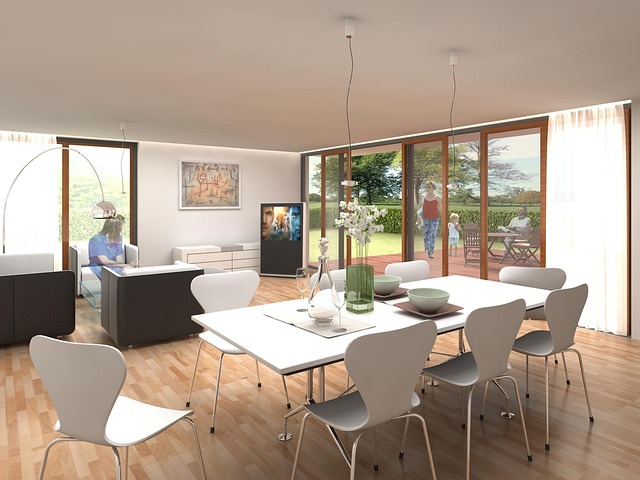AR/VR technologies revolutionize architectural 3D modeling by creating immersive experiences. These tools allow architects to build interactive visualizations, enabling clients to explore buildings virtually before construction. By merging AR and VR with architectural 3D modeling, designers enhance client engagement, improve communication, and drive faster project adjustments, ultimately elevating both satisfaction and design quality. This fusion of technologies promises more efficient, collaborative, and cost-effective architectural processes, leading to innovative, immersive built environments.
“Explore the future of architecture and design with augmented reality (AR) and virtual reality (VR). This transformative technology duo is revolutionizing architectural visualizations, offering immersive experiences in 3D modeling software, and enhancing client engagement through interactive design. Discover how AR/VR integrates seamlessly with architectural 3D modeling to create dynamic, realistic projects that captivate and inform. From concept to completion, these technologies are reshaping the industry.”
AR/VR: Transforming Architectural Visualizations
Augmented and virtual reality technologies are revolutionizing the way architects present and interact with their designs, offering a compelling shift from traditional 2D drawings to immersive 3D experiences. AR/VR provides an innovative platform for architectural visualizations, allowing potential clients to virtually walk through buildings before construction even begins. This interactive approach not only enhances understanding but also enables designers to gather valuable feedback, making adjustments in real-time.
With architectural 3D modeling at the forefront, AR and VR technologies bring designs to life by presenting them in a realistic, virtual environment. Users can explore intricate details, manipulate spaces, and experience the flow of a structure as if it already existed. This immersive experience fosters collaboration among stakeholders, from developers and investors to potential residents, ensuring everyone aligns with the building’s final vision.
Immersive Experiences in 3D Modeling Software
The integration of Augmented Reality (AR) and Virtual Reality (VR) technologies is transforming the way we interact with digital content, particularly in architectural 3D modeling software. These immersive experiences allow designers and architects to visualize their creations in a whole new dimension, providing a more intuitive and lifelike representation of their designs. With AR, users can overlay digital models onto real-world spaces, enabling them to see how buildings or structures would fit into their surroundings. This not only enhances the design process but also facilitates better client communication.
VR takes immersion to the next level by creating entirely virtual environments where users can walk through and interact with 3D models. This technology is particularly useful for architectural walkthroughs, allowing clients to experience a space before construction even begins. By combining AR and VR in 3D modeling software, architects can offer more interactive and engaging experiences, ensuring their designs are not only visually appealing but also functional and practical from every angle.
Interactive Design: Client Engagement Enhanced
Interactive design powered by AR and VR technologies significantly enhances client engagement in various industries, including architecture. By integrating architectural 3D modeling into immersive virtual environments, designers can offer clients a dynamic and interactive experience. This allows them to explore and interact with designs in real-time, providing a more intuitive understanding of the final product.
The result is a deeper level of involvement where clients can virtually walk through buildings, change design elements, and make informed decisions on the spot. This interactive approach not only boosts client satisfaction but also facilitates faster project iterations and adjustments based on immediate feedback. It transforms the traditional architectural process into an engaging journey that fosters collaboration and creativity.
Future of Architecture: Augmented & Virtual Reality
The future of architecture is set to be transformed by the integration of Augmented Reality (AR) and Virtual Reality (VR). These immersive technologies offer architects and designers unprecedented opportunities to create, visualize, and interact with their projects in entirely new ways. With architectural 3D modeling at its core, AR allows for a seamless blend of digital designs over physical spaces, enabling clients to experience future structures as if they were already built. VR, on the other hand, provides a complete digital sanctuary where architects can craft intricate models, simulate different lighting and environmental conditions, and gather valuable feedback from stakeholders in a virtual setting.
By combining AR and VR, architectural processes become more efficient and accessible. Designers can virtually collaborate, walk through digital prototypes, and make informed decisions faster. This not only reduces the time and cost of construction but also enhances the overall quality of designs. As these technologies continue to evolve, we can expect even more sophisticated applications that blur the line between physical and digital architectures, opening up exciting possibilities for innovative and immersive built environments.
Augmented and virtual reality technologies are revolutionizing the way we interact with digital content, particularly in architectural 3D modeling. From enhancing client engagement through interactive design to transforming visualizations, AR and VR offer a new dimension of immersive experiences. As these technologies continue to evolve, they will undoubtedly shape the future of architecture, making it more accessible, engaging, and innovative for professionals and enthusiasts alike.
